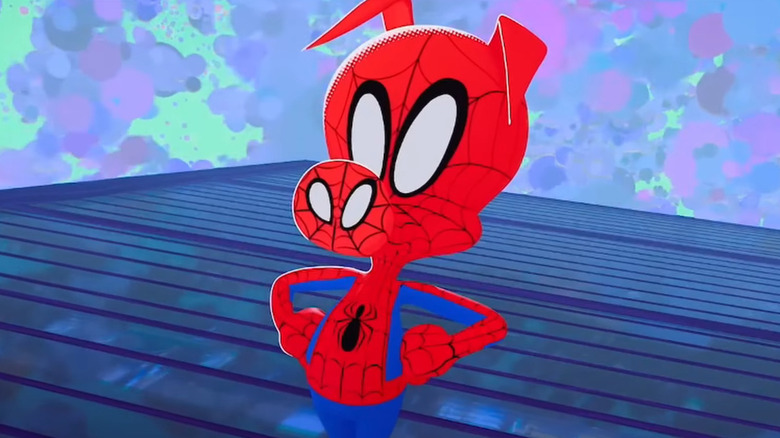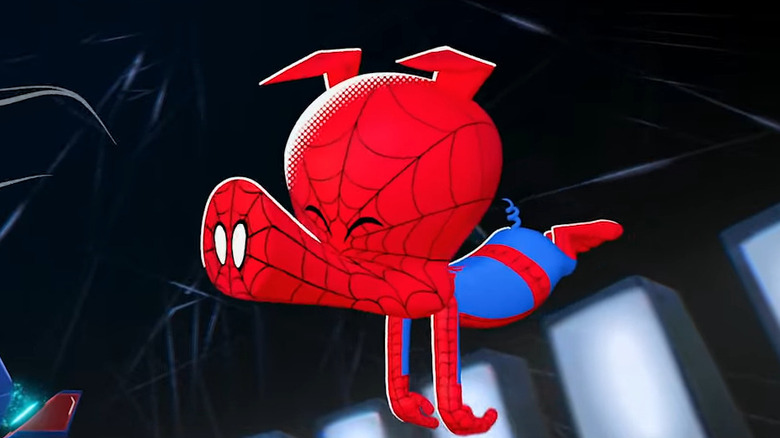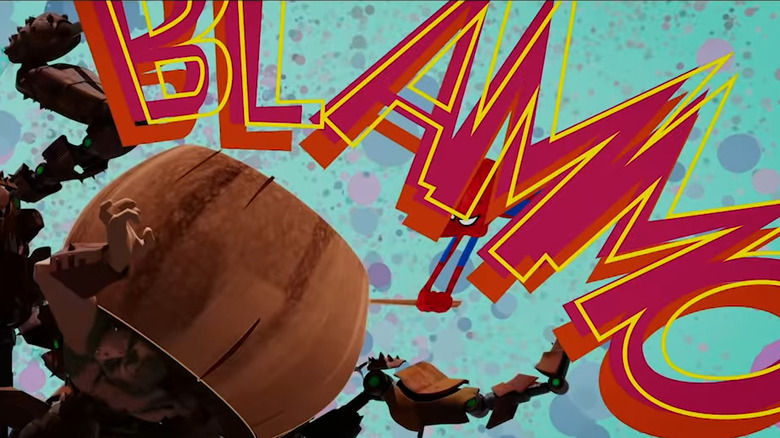Spider-Man: Across The Spider-Verse: What Is Hammer Space And How Does It Work?
"Spider-Man: Across the Spider-Verse" is one of those rare sequels that exceeds expectations, due in part to how it embraces the dazzling combination of animation styles pioneered by its predecessor. While the film is certainly a visual feast for Marvel fans and webheads alike, it's yet another unabashedly passionate love letter to the animated medium, including references to such beloved concepts as "Hammer Space."
For "Spider-Verse" fans, Hammer Space is mostly associated with John Mulaney's cartoonish, porkish web-slinger, Spider-Ham. Hailing from an Earth inhabited by "Looney Tunes"-esque quasi-anthropomorphic animals, Spider-Ham is shown throughout the entirety of the first film to be able to produce impossible objects from baffling places no matter what universe he's in. For example, while fighting the Scorpion of Earth-1610, Spider-Ham makes an anvil fall from the sky in true Road Runner fashion; before he returns to his home world, he gifts Miles Morales (Shameik Moore) a hammer that he claims "can fit in your pocket."
His last line in "Into The Spider-Verse" was already a reference to a power that is named by Miguel O'Hara (Oscar Isaac) during his fight with the Da Vinci Vulture at the top of "Across the Spider-Verse." Though it may seem like a clever tongue-in-cheek invention for Spider-Ham or even the Marvel universe at large, it's actually a decades-old term coined for a longstanding animation trope.
Where did Hammer Space come from?
The exact origins of Hammer Space (or hammerspace as it is commonly written) are not precisely known, though some well-founded theories have been offered over the years. The concept itself is widely attributed to the Golden Age of Animation, which began at the end of the 1920s with companies like Warner Bros. Animation, Hanna-Barbera, and Walt Disney Studios rising to prominence.
Hammer Space wasn't written as a distinct power until later on. Some fans attribute the first instances of characters actually pointing out their ability to produce objects from nowhere to Japanese animation and comics — it is also believed by some that this is where the term Hammer Space came from in the first place (likely from the community of fans). However, others believe that the role-playing game "Dungeons and Dragons" was the first to establish the convenient mechanic as an outright magical ability through the Bag of Holding — though, by that standard, it would arguably be more rightly attributed to the 1934 literature character Mary Poppins, who carries a carpetbag with seemingly infinite contents.
Regardless of where Hammer Space came from, it has long been a part of the Marvel Universe as an established superpower. Though its use is often in homage to animation, the narrative explanation for its existence is unique to the comics.
How does Hammer Space work in the Marvel Universe?
In the Marvel Universe, Spider-Ham is just one of a few characters capable of accessing Hammer Space, another prominent one being the clownish anti-hero and sometimes "Deadpool" supporting character Slapstick. Whatever hero or villain is using Hammer Space, its existence is usually explained as being some sort of pocket dimension.
A pocket dimension — at least in Marvel Comics — is a space outside the normal universe that is drastically smaller than larger counterparts such as the Dark Dimension. A popular example of a pocket dimension can be seen at the end of the Disney+ series "What If...?," in which variants of Arnim Zola (Toby Jones) and Erik "Killmonger" Stevens (Michael B. Jordan) are trapped in a small dimension where they will wrestle over the Infinity Stones seemingly for eternity. The dimension is made small enough to fit in the hands of Doctor Strange Supreme (Benedict Cumberbatch).
For Spider-Ham specifically, it's likely that he has access to a small pocket dimension through a portal in, well, his pocket, where he has stored various weapons and objects that he feels would be useful in future battles. We'll likely get to see more of Hammer Space when Spider-Ham makes his return in 2024's "Spider-Man: Beyond the Spider-Verse."


